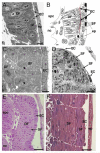Generality of vertebrate developmental patterns: evidence for a dermomyotome in fish
- PMID: 16409387
- PMCID: PMC3360970
- DOI: 10.1111/j.1525-142X.2006.05079.x
Generality of vertebrate developmental patterns: evidence for a dermomyotome in fish
Erratum in
- Evol Dev. 2006 Mar-Apr;8(2):239
Abstract
The somitic compartment that gives rise to trunk muscle and dermis in amniotes is an epithelial sheet on the external surface of the somite, and is known as the dermomyotome. However, despite its central role in the development of the trunk and limbs, the evolutionary history of the dermomyotome and its role in nonamniotes is poorly understood. We have tested whether a tissue with the morphological and molecular characteristics of a dermomyotome exists in nonamniotes. We show that representatives of the agnathans and of all major clades of gnathostomes each have a layer of cells on the surface of the somite, external to the embryonic myotome. These external cells do not show any signs of terminal myogenic or dermogenic differentiation. Moreover, in the embryos of bony fishes as diverse as sturgeons (Chondrostei) and zebrafish (Teleostei) this layer of cells expresses the pax3 and pax7 genes that mark myogenic precursors. Some of the pax7-expressing cells also express the differentiation-promoting myogenic regulatory factor Myogenin and appear to enter into the myotome. We therefore suggest that the dermomyotome is an ancient and conserved structure that evolved prior to the last common ancestor of all vertebrates. The identification of a dermomyotome in fish makes it possible to apply the powerful cellular and genetic approaches available in zebrafish to the understanding of this key developmental structure.
Figures




Similar articles
-
Signals and myogenic regulatory factors restrict pax3 and pax7 expression to dermomyotome-like tissue in zebrafish.Dev Biol. 2007 Feb 15;302(2):504-21. doi: 10.1016/j.ydbio.2006.10.009. Epub 2006 Oct 10. Dev Biol. 2007. PMID: 17094960 Free PMC article.
-
Expression patterns of collagen I (alpha1) encoding gene and muscle-specific genes reveal that the lateral domain of the fish somite forms a connective tissue surrounding the myotome.Dev Dyn. 2005 Jun;233(2):605-11. doi: 10.1002/dvdy.20337. Dev Dyn. 2005. PMID: 15768397
-
BMP regulation of myogenesis in zebrafish.Dev Dyn. 2010 Mar;239(3):806-17. doi: 10.1002/dvdy.22243. Dev Dyn. 2010. PMID: 20151472 Free PMC article.
-
[A dermomyotome in fish?].Med Sci (Paris). 2010 May;26(5):504-8. doi: 10.1051/medsci/2010265504. Med Sci (Paris). 2010. PMID: 20510149 Review. French.
-
Evolution and development of distinct cell lineages derived from somites.Curr Top Dev Biol. 2000;48:1-42. doi: 10.1016/s0070-2153(08)60753-x. Curr Top Dev Biol. 2000. PMID: 10635456 Review.
Cited by
-
Temperature-dependent modification of muscle precursor cell behaviour is an underlying reason for lasting effects on muscle cellularity and body growth of teleost fish.J Exp Biol. 2011 Jun 1;214(Pt 11):1791-801. doi: 10.1242/jeb.050096. J Exp Biol. 2011. PMID: 21562165 Free PMC article.
-
Differential requirements for myogenic regulatory factors distinguish medial and lateral somitic, cranial and fin muscle fibre populations.Development. 2009 Feb;136(3):403-14. doi: 10.1242/dev.028019. Development. 2009. PMID: 19141670 Free PMC article.
-
Cellular dynamics of regeneration reveals role of two distinct Pax7 stem cell populations in larval zebrafish muscle repair.Dis Model Mech. 2016 Jun 1;9(6):671-84. doi: 10.1242/dmm.022251. Epub 2016 May 5. Dis Model Mech. 2016. PMID: 27149989 Free PMC article.
-
Postembryonic fast muscle growth of teleost fish depends upon a nonuniformly distributed population of mitotically active Pax7+ precursor cells.Dev Dyn. 2009 Sep;238(9):2442-8. doi: 10.1002/dvdy.22049. Dev Dyn. 2009. PMID: 19653317 Free PMC article.
-
Myoblast fusion: when it takes more to make one.Dev Biol. 2010 May 1;341(1):66-83. doi: 10.1016/j.ydbio.2009.10.024. Epub 2009 Nov 20. Dev Biol. 2010. PMID: 19932206 Free PMC article. Review.
References
-
- Armand O, Boutineau AM, Mauger A, Pautou MP, Kieny M. Origin of satellite cells in avian skeletal muscles. Arch Anat Microsc Morphol Exp. 1983;72:163–181. - PubMed
-
- Ben-Yair R, Kahane N, Kalcheim C. Coherent development of dermomyotome and dermis from the entire mediolateral extent of the dorsal somite. Development. 2003;130:4325–4336. - PubMed
-
- Ben-Yair R, Kalcheim C. Lineage analysis of the avian dermomyotome sheet reveals the existence of single cells with both dermal and muscle progenitor fates. Development. 2005;132:689–701. - PubMed
-
- Bone Q. Locomotor muscle. In: Hoar WS, Randall DJ, editors. Fish Physiology. Academic Press; New York: 1978. pp. 361–424.
Publication types
MeSH terms
Substances
Grants and funding
LinkOut - more resources
Full Text Sources
Other Literature Sources
Molecular Biology Databases

